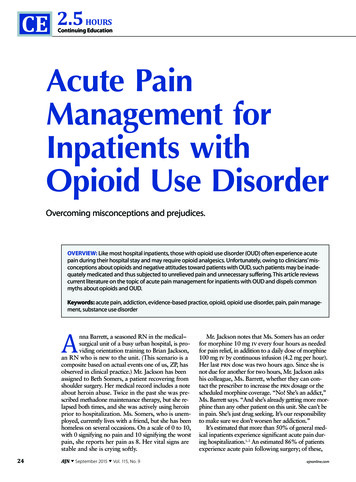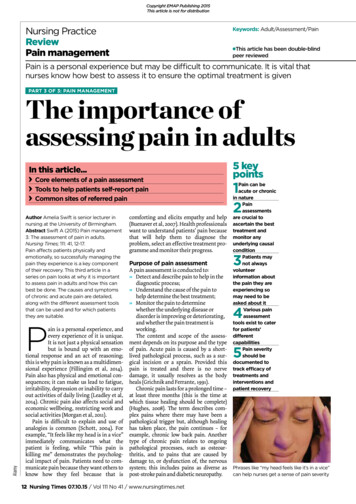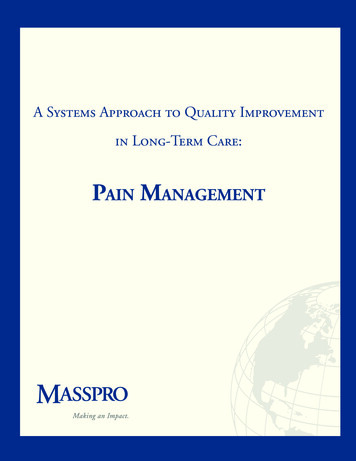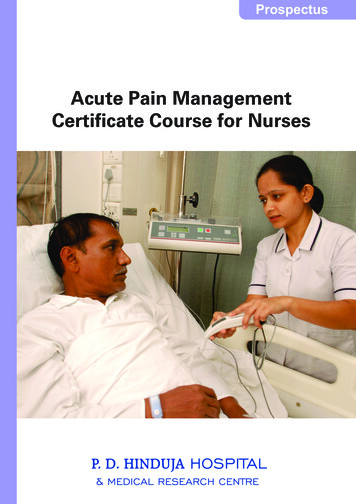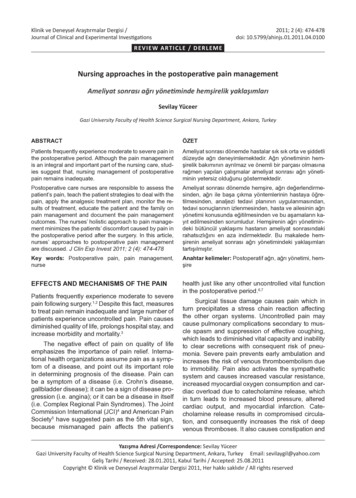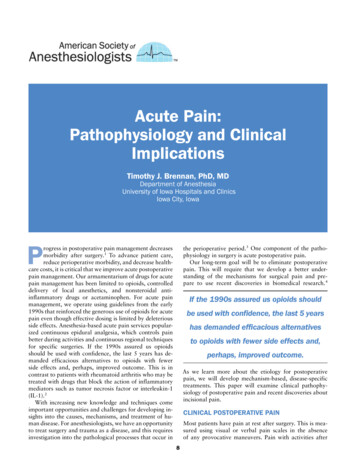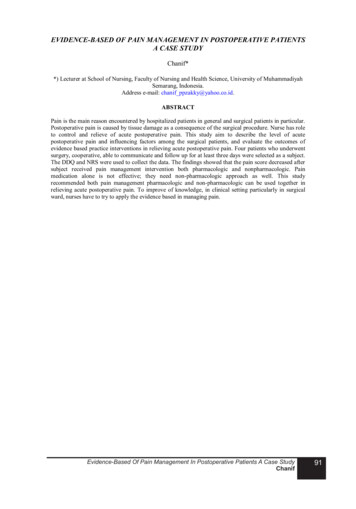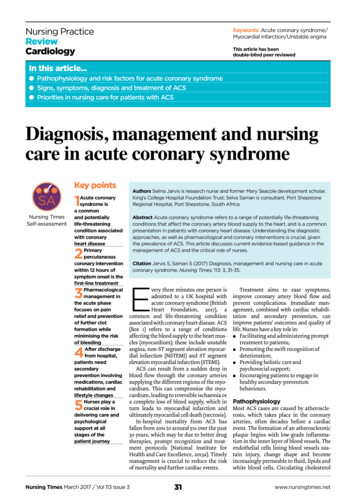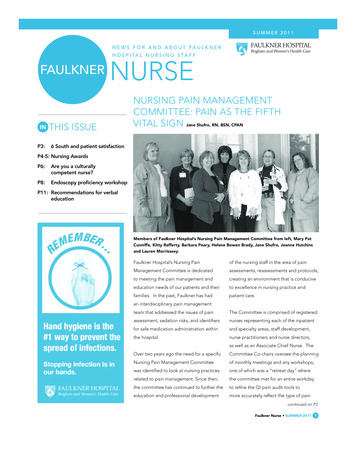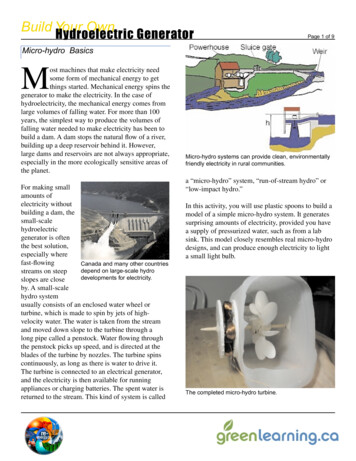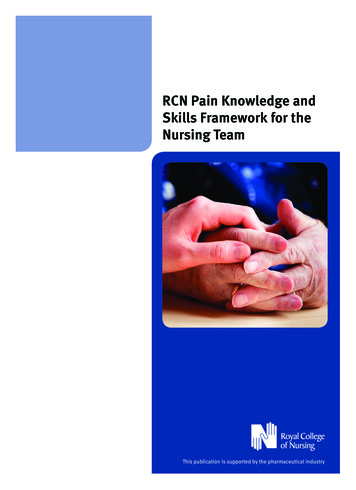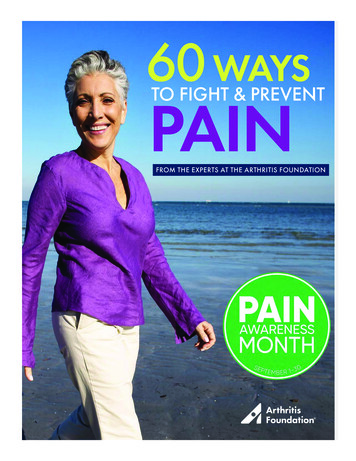
Transcription
60 WAYSTO FIGHT & PREVENTPAINFROM THE EXPERTS AT THE ARTHRITIS FOUNDATION
Plan to Stop PainUSE THESE TOOLS TO CREATE YOUR PERSONALIZEDPLAN TO PUTTING A STOP TO YOUR PAIN.When you live with arthritis, pain often strikes without warning, stealing joy and independence.But you have the power to put pain in its place — and to say YES! to living your best life.By creating your own personalized arthritis pain plan, you can take steps to stoppain or even prevent it. Identifying what triggers your pain is one of the bestfirst steps you can take to preventing it. Keep a pain journal and share itwith your doctor, so together you can pinpoint triggers.Expect a trial-and-error approach to pain-relief therapies until youfind what works for you. Try a variety of options so you have severaltherapies to choose from when needed. (To learn more, tune in to theArthritis Foundation’s Live Yes! With Arthritis Podcast: BuildingYour Personal Pain Plan.)Use this knowledge and these 60 tips in your personalized pain planto get the relief you deserve.CONTENTS1 Introduction2 Know What Factors Affect Pain3 Tell Your Doctor4 Stay Physically Active5 Sleep Soundly6 Stress Less7 Eat Well8 Know Your Meds9 Soothe and Protect Joints10 Consider Alternatives1 ARTHRITIS FOUNDATION ARTHRITIS.ORG
Know What FactorsAffect PainIn theArthritis FoundationINSIGHTS survey,92% of respondentsreported that paininterferes with dailyactivities.LOCATION, SEVERITY AND QUALITY. Thesecan help indicate the source of your pain and itstreatments. For example, dull, aching pain in your shoulder could indicate muscle strain or arthritis; tingling inyour fingers might suggest nerve pain.142SMOKING. Evidence is clear that smoking worsens chronic diseases and can interfere with medications used to treat them. Research shows chronicpain patients who smoke have worse pain than nonsmokers. Smoking also is linked to more pain from RA,osteoarthritis (OA) and psoriatic arthritis (PsA).EMOTIONAL RESPONSE. People who maintaina positive outlook and accept pain rather than letting it consume them experience less pain. Those whocatastrophize – view it fatalistically – experience morepain and less ability to function.3STRESS. Stress is more likely to lead to developing rheumatoid arthritis (RA) or a flare. What’smore, stressed-out people tend to skip healthy habitslike exercise that could reduce pain. And stress causesanxiety and muscle tension, which worsens pain.HEALTH HABITS. Eating healthfully, staying physically active and getting enough restful sleep are allcritical to good overall health and reducing pain levels. Moving is especially important for people with jointpain, and poor sleep is associated with higher pain.56COPING MECHANISMS. People with strongsocial systems fare better with pain, whereasloneliness is intertwined with worse disease and morepain. (Learn more by listening to the Live Yes! WithArthritis podcast on Reframing Pain.)2 ARTHRITIS FOUNDATION ARTHRITIS.ORG
Tell Your DoctorA recent studyof cancer patientsshowed using a paindiary helped reducetheir pain.7CHOOSE YOUR WORDS. To help guide yourtreatment, choose words that best describe yourpain, such as dull, aching, tender, shooting, tingling,burning, stabbing or throbbing.8WHERE IS THE PAIN? Does it stay in one areaor move around? For example, is it deep in yourshoulder or in the muscles near the surface; under thekneecap or in the back of the knee; in the outside ofyour hip or in your groin?9WHEN DOES IT HURT? How long have youhad the pain? Is it consistent or does it come andgo? Does it occur when you move in certain ways?10HOW DOES IT AFFECT YOUR ACTIVITIESAND LIFE? What have you had to adjust oravoid? Have you had to miss work or classes? Is ithard to get out of bed in the morning? Have you beenskipping your morning walk? Does it leave you sodrained that you aren’t doing things you normally enjoy?11HOW MUCH DOES IT HURT? Your doctorwill ask you to rate the intensity of your painon a scale of 0 to 10, where 0 is pain-free and 10 isunimaginable pain. Let your doctor know your baseline level of pain — what you typically experience —as well as the highs and lows. Your doctor can use thisinformation to help determine how much and whattype of treatment you need.12KEEP A PAIN JOURNAL. Note when yourpain is better or worse, the time of day or night,and what activities you’re engaged in before and atthe time. This information can help you understand andadjust your activities (Are you overdoing or underdoing it with your activity levels?) and help your doctordetermine timing and dosage of medications.3 ARTHRITIS FOUNDATION ARTHRITIS.ORG
Stay Physically ActiveRegular physicalactivity has been shownto ease arthritis painalmost as well as overthe-countermedications.13MOVEMENT IS MEDICINE. Studies showregular physical activity can reduce arthritis painand stiffness and improve functioning by as much as40%. It also can boost your mood and cognitive function.14CONSULT AN EXPERT. Especially if you’rejust starting out, a physical or occupationaltherapist can provide exercise options that are safe forarthritic joints and modifications for everyday movements to avoid added strain and pain.higher impact activities like running may be OK, butcheck with your health care team before trying them.17MAKE IT WELL-ROUNDED. A well-rounded,weekly routine should include strength training,stretching, and cardiovascular and balance exercises.Stronger muscles help support your joints. Pick activities that are fun so you stick with it!18START SLOW. Warm up at least 10 minutesbefore each session to increase flexibility andhelp prevent injuries. Slowly, over weeks, increasethe intensity and time of workouts.15IT ALL COUNTS. Whether it’s a gym workout, a trip to the mailbox or house chores, allphysical activity counts, and it all adds up. So your 30minutes a day of moderate intensity exercise mightmean 5 minutes of vacuuming, 10 minutes of groceryshopping and a 10-minute walk around the block.1619GO LOW. Low-impact exercise — walking,swimming, cycling, yoga, tai chi — are goodoptions for people with arthritis. (Check out the ArthritisFoundation’s Walk With Ease program.) SomeDON’T OVERDO IT. Some pain while exercising isn’t necessarily cause for alarm. But if itpersists two hours after you’ve stopped working out,avoid activity until you’ve consulted your doctor.4 ARTHRITIS FOUNDATION ARTHRITIS.ORG
Sleep SoundlyAs many as80% of people witharthritis reporttrouble sleeping.20KEEP A REGULAR SLEEP SCHEDULE.Not only does pain disrupt sleep, but poorsleep exacerbates pain, so getting adequate restfulsleep is vital. Go to bed and get up at the same timesevery day, even on weekends. (Tune in to the ArthritisFoundation’s podcast on Sleep and Painsomnia.)21GET DAILY EXERCISE. Physical activitycontributes to more restful sleep. But don’t doan intense workout right before bedtime.22TAKE A BATH. A warm bath or showersoothes pain and is relaxing. Plus, the drop intemperature helps prepare your body for sleep.23TURN DOWN THE TEMP. Keep your bedroom dark and cool. Too much warmthcould disrupt sleep. The optimal temperature forsleeping is 65 degrees. Cooling sheets that wickaway moisture may also help.24FORGO THE NIGHTCAP. Alcohol mighthelp you get to sleep but it disrupts the sleepcycle. Also, avoid caffeine too late in the day or itmight keep you awake.25POSITION YOUR PILLOWS. Use pillows tosupport joints and keep your body in alignment. Back sleeper? Use a thin pillow that won’t pushyour head up, and place pillows under your knees tosupport your back and hips. On your side, place onebetween your legs or hug a firm, king-size pillow withyour arms and legs. An occupational therapist cansuggest sleep positions to help you get your ZZZs.5 ARTHRITIS FOUNDATION ARTHRITIS.ORG
Stress LessMindfulnessmeditation after brieftraining has been shownto reduce how peopleexperience pain.26BREATHE DEEP. A quick, simple techniqueto reduce stress – which drives inflammationand pain – is deep, measured breathing.27TAKE NOTE. Each evening, write aboutsomething that made you smile that day.When you need a pick-me-up, reread your notes.2830GET SOCIAL. Spending time doing something you love with people you love is agreat way to ease stress. Join an online book club orgo for a hike with your favorite person.31GET YOUR HEART PUMPING. Cardiovascular exercise gets feel-good hormonessurging and reduces pain-provoking stress levels.MEDITATE. No need to sit cross-leggedand chant. Learn to simply focus on the present without letting distractions intrude. Check out theLive Yes! With Arthritis Podcast on Mindfulness tolearn more about incorporating this practice intoyour routine. It includes a bonus short meditation.TAKE A WALK IN A PARK. This blendsexercise with the stress-busting benefits ofgetting outside in nature, what’s known in Japan as“forest bathing.”29TALK IT OUT. Having trouble managingstress on your own? Consider seeking professional help. Cognitive behavioral therapy, a type oftalk therapy, is a proven way to deal with stress.TRY AN APP like Headspace or Calm tohelp your mindful meditation practices.32336 ARTHRITIS FOUNDATION ARTHRITIS.ORG
Eat WellResearch hasshown a Mediterraneandiet can improve bothosteoarthritis andinflammatory arthritissymptoms.34DIVE INTO MEDITERRANEAN. Indulge inmore fruits, veggies, whole grains and fishand less red meat for an anti-inflammatory diet thatmay help reduce pain in the long run.37GIVE SUGAR A PASS. Too much sugar is aculprit not only in inflammation but also inweight gain.3835PROCESS LESS. Avoid highly processedmeats, refined grains and foods that containthem, like white breads and cold-cut sandwiches.UP THE OMEGA-3S. Olive oil, walnut oil,salmon, sardines and other foods rich inomega-3 fatty acids may help ease inflammationand pain.3639CUT UNHEALTHY FATS. Eliminate transfats, often added to foods to extend shelflife, and limit saturated fats. Instead, look for healthymono- and polyunsaturated fats – but remember thatthey are still fats, so don’t overdo it.DON’T OVEREAT. It pays to maintain ahealthy weight. Excess body fat not only feedsinflammatory processes, but it also adds to joint pressure. Every pound lost equals four pounds less pressureon weight-bearing joints like hips and knees.7 ARTHRITIS FOUNDATION ARTHRITIS.ORG
Know Your MedsBe sure you knowwhat your meds are for,their side effects, howto take them and thebest time to takethem.40NSAIDS. Over-the-counter (OTC) nonster oidal anti-inflammatory drugs, like ibuprofen(Advil) or naproxen (Aleve) may be all you needsometimes. Many cough, cold and other OTC medscontain them, so beware of taking too much, whichcan cause GI bleeding and even stroke.41TOPICALS. NSAIDS also come in topicalform, such as sodium diclofenac (VoltarenArthritis Pain Gel). Other topicals contain numbingagents like capsaicin or lidocaine.42CORTICOSTEROIDS. These tamp downinflammation by mimicking the hormone cortisol. They can provide fast relief from a flare by suppressing the immune system, which raises infection risk.Joint injections can weaken tissues supporting the joint.43DMARDS. Disease-modifying antirheumaticdrugs such as methotrexate (Trexall), hydroxychloroquine (Plaquenil), sulfasalazine (Azulfidine) orleflunomide (Arava) can quickly suppress inflammation, which slows the disease process, but raises therisk of infection. Targeted DMARDs, a new type, act onspecific cells and pathways in the immune system.44BIOLOGICS. These complex medications,given by injection or infusion, target specificactivities in the immune system to slow the diseaseprocess. Biosimilars are intended to be less expensiveversions, but only a few are available in the U.S.45ANTIDEPRESSANTS. These act on neuro transmitters to ease how one experiencespain. A few are approved for musculoskeletal painand fibromyalgia.46OPIOIDS. These drugs are effective painrelievers and can safely be used for shortterm relief, but they carry risks of dependence andoverdose. They may lose effectiveness over time,and it’s not clear that higher doses help pain.8 ARTHRITIS FOUNDATION ARTHRITIS.ORG
Soothe and ProtectResearch showsthat using splints,hot packs and exercisesfor hand OA can improvepain, stiffness, gripand function.475048514952APPLY COLD. It’s best for acute joint painfrom surgery, an injury, overusing a joint or aflare. Cold slows blood flow, numbs nerve endingsand reduces swelling. Place a towel or other barrierbetween your skin and the cold source to avoid frostnip, and only apply it 15 to 20 minutes at a time.APPLY HEAT, TOO. Heat increases bloodflow to painful joints and relaxes muscles. Awarm bath or shower, heating pad or paraffin bathfor small joints all work well. Like cold, apply heat forno more than 15 to 20 minutes at a time.MODIFY IT. A physical or occupationaltherapist (OT) can teach you how to modifydaily tasks by moving your joints safely or providingassistive devices. For example, if turning a doorknobis hard, an OT might suggest replacing the doorknobwith a lever or demonstrating a better way to gripand turn the knob.STRETCH IT. Gentle stretching and lightmovement can help aching joints, evenduring a flare or on your most painful days. Hold thestretch and increase it a tiny bit at a time over the session, and avoid bouncing as you stretch.FLEX IT. Isometric exercises, like those oftenprescribed by physical therapists and occupational therapists, involve flexing and holding muscleswithout moving joints. They can provide pain reliefand fitness benefits, including increased strength.ADAPT IT. Adaptive devices, such as canes,walkers, splints, braces, shoe inserts andothers, are available over the counter at pharmacies.While these can prove helpful in easing pain andmaintaining mobility, it’s best to see a physical oroccupational therapist to be properly fitted and informedabout the adaptive device.9 ARTHRITIS FOUNDATION ARTHRITIS.ORG
Consider AlternativesTAKEACTION NOW!Build your personalpain plan with ourBetter LivingToolkit.54NERVE STIMULATION. Stimulating nerveswith low electrical pulses may provide shortterm pain relief. One method, transcutaneous electricalnerve stimulation (TENS), is sometimes used to treatOA pain; however, evidence that it helps is poor.55HYALURONIC ACID. Expert opinionsabout this injectable therapy are mixed.Some guidelines no longer recommend it for kneeOA, citing studies that didn't find benefits. Otherguidance continues to recommend it, noting that it’ssafer than corticosteroid injections.56ACUPUNCTURE. Some studies show acupuncture may ease pain from OA in certainjoints and from RA and fibromyalgia pain. Evidenceis mixed, but there’s little risk to trying it.57REGENERATIVE MEDICINE. Techniques torebuild cartilage – such as platelet rich plasmaand stem cell therapy – are promising, but evidence isscarce that they relieve symptoms. If you are considering stem cell therapy, learn more about it and readthe Arthritis Foundation’s position statement.58RADIOFREQUENCY ABLATION uses radiofrequency waves to burn pain-sensingnerves for spinal arthritis and other joints, too. Reliefmay last only six months to a year.59CBD. Cannabidiol may reduce pain andinflammation, but more research is needed.Learn more in the Arthritis Foundation’s CBDGuidance for Adults With Arthritis.60SURGERY. Surgery may fix the source ofthe pain, such as bone grinding on bone ortissue tears, but it generally should be used only afterless invasive options have been exhausted. (Learnmore in the podcast on Arthritis Pain and Surgeryand Pain Management Strategies webinar.)10 ARTHRITIS FOUNDATION ARTHRITIS.ORG
It’sGREATTo Meet YouWe’re so excited to have you in our communityand can’t wait to help you Live Your Yes!Helpful ResourcesTo get started on your personal journey, we hope you’ll take advantage of some of themany tools and resources designed for you. Here are a few to get you started. J oin a Live Yes! Connect Group or the Online Community today to make connections andget information and resources to help you manage your pain. H ave questions? Our licensed clinical staff is available to you to provide one-on-onepersonal support. A variety of tools are accessible online to help you reduce pain, promote your independenceand live your best life — including our new Vim mobile app. Ready to connect locally? Check out programs and events in your area.SupportResources like this e-book are made possible by the generosityof our donors. Please consider making a gift today!DONATEarthritis.org
Content developed exclusively by the Arthritis Foundation.SPONSORED BYPresentingChampion
When you live with arthritis, pain often strikes without warning, stealing joy and independence. But you have the power to put pain in its place — and to say YES! to living your best life. By creating your own personalized arthritis pain plan, you can take steps to stop pain or even prev
